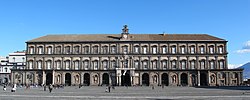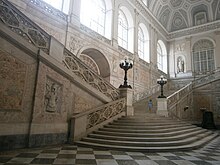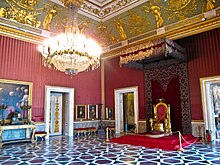Royal Palace of Naples
| Royal Palace of Naples | |
|---|---|
| |
 Royal Palace façade | |
 | |
| General information | |
| Type | Palace |
| Architectural style | Italian Baroque, Neo-Classical |
| Location | Naples, Italy |
| Address | Piazza del Plebiscito 1 |
| Coordinates | 40°50′10″N 14°14′59″E / 40.8362°N 14.2496°E |
| Website | |
| palazzorealenapoli | |
Invalid designation | |
| Official name | Palazzo Reale di Napoli |
| Type | Non-movable |
| Criteria | Monument |



The Royal Palace of Naples (Italian: Palazzo Reale di Napoli; Neapolitan: Palazzo Riale 'e Napule) is a palace, museum, and historical tourist destination located in central Naples, southern Italy.
It was one of the four residences near Naples used by the
Vesuvius
.
History
The palace is on the site of an earlier residence, which had housed the former
Don Pedro de Toledo, Marquis of Villafranca. Construction on the present building was begun in the 17th century by the architect Domenico Fontana.[1] Intended to house King Philip III of Spain on a visit never fulfilled to this part of his kingdom, instead it initially housed the Viceroy Fernando Ruiz de Castro, Count of Lemos. By 1616, the facade had been completed, and by 1620, the interior was frescoed by Battistello Caracciolo, Giovanni Balducci, and Belisario Corenzio. The decoration of the Royal Chapel of the Assumption (Cappella Reale dell'Assunta) was not completed until 1644 by Antonio Picchiatti
.
In 1734, with the arrival of
Francesco De Mura and Domenico Antonio Vaccaro helped remodel the interior. It was Charles who build the other three palaces in locations more peripheral to the city center. Further modernization took place under Ferdinand I of the Two Sicilies. In 1768, on the occasion of his marriage to Maria Carolina of Austria, under the direction of Ferdinando Fuga, the great hall was rebuilt and the court theater added. During the second half of the 18th century, a "new wing" was added, which in 1927 became the Vittorio Emanuele III National Library
. By the 18th century, the royal residence was moved to the Palace of Caserta, as that inland town was more defensible from naval assault, as well as more distant from the often-rebellious populace of Naples.
During the
Pedro de Toledo
.
In 1922, it was decided (by the Decree of the Minister
National Archaeological Museum of Naples
). The transfer of library collections was made by 1925.
The library suffered from
Teatro San Carlo
, the smaller Teatrino di Corte (recently restored), the Biblioteca Nazionale Vittorio Emanuele III, a museum, and offices, including those of the regional tourist board.
Statues of kings of Naples
In 1888, King
Vittorio Emanuele II, the tallest statue and the last to be added (sculpted by Francesco Jerace
).
The other figures represent:
- Frederick II Hohenstaufen (by Emanuele Caggiano)
- Charles I of Anjou (sculpted by Tommaso Solari)
- Alfonse of Aragon (sculpted by Achille D'Orsi)
- Emperor Charles V (sculpted by Vincenzo Gemito)
- Charles III of Spain (sculpted by Raffaele Belliazzi)
- Joachim Murat (sculpted by Giovanni Battista Amendola)
None of the statues refers to the Bourbon dynasty, not even Charles of Bourbon, who is actually engraved with the name of Charles III.
-
Roger the Norman(Roger II of Sicily)
-
Alfonso V of Aragon (Alfonso I of Naples)
-
Charles V, Holy Roman Emperor (Charles I of Spain)
-
Charles III of Spain (Charles of Bourbon)
-
Gioacchino Murat
-
Vittorio Emanuele II
See also
References
- ^ The "signature" of Domenico Fontana is engraved on some bases of the columns of the facade of the Royal Palace of Naples. The text states: "DOMENICVS FONTANA PATRITIVS Romanvs / AVRATAE Militiae EQVES / ET COMES PALATINVS INVENTOR."
- ^ "MEDRANO, Giovanni Antonio - Treccani". Treccani (in Italian). Retrieved 2024-01-01.
External links
Wikimedia Commons has media related to Royal Palace (Naples).









